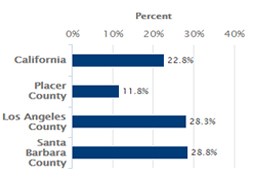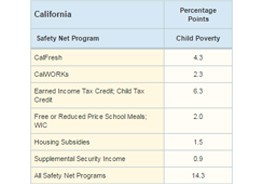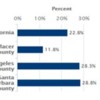Kidsdata and Public Policy Institute of California (PPIC) have partnered to release the latest data on poverty among California's children. Poverty and inequitable distribution of resources are fundamental impediments to healthy and well children. Addressing poverty among all children must be a key part of programs and policies that aim to maximize health and well being.
Guest author, Caroline Danielson, who is a senior fellow at the Public Policy Institute of California, shares important findings about poverty in California:
Measuring Poverty
Poverty is high in California, and it has not improved as much as the growing economy might suggest it should. In fact, California's poverty rate and child poverty rate are both the highest in the country, according to Census Bureau estimates from the Supplemental Poverty Measure (SPM). The California Poverty Measure (CPM), an ongoing collaboration between the Public Policy Institute of California and the Stanford Center on Poverty and Inequality, is a state-specific, updated measure of the adequacy of the resources families have on hand to meet their basic needs. The CPM improves on official poverty statistics by accounting for sharply differing housing costs across counties and by incorporating major social safety net programs like the federal and state Earned Income Tax Credits (EITC), CalFresh food assistance, and CalWORKs cash assistance for low-income families with children.
Poverty in California
According to the CPM, 19.5% of Californians were poor as of 2015-that means 7.5 million people living below a basic needs threshold (on average less than $30,000 in total resources for a family of four). The poverty rate is higher for children at 22.8%, or over 2 million children in 2013-2015. Among counties with data, CPM poverty rates ranged from 11.8% in Placer County to over 28% in Los Angeles and Santa Barbara counties.
Poverty Increase without Safety Net
Without resources from the social safety net, we estimate that an additional 1.3 million children, or 14.3%, would live in poverty based on data from 2013-2015. This translates into over one-third of children in poverty (37.1%). In other words, social safety net programs are doing critical work to mitigate poverty in the state.
Deep Poverty
For children living in deep poverty (with family resources less than half of the poverty threshold), social safety net programs are even more consequential. We estimate 5.1% of children lived in deep poverty in 2013-2015, but that nearly three and one-half times that share would live in deep poverty absent resources from the social safety net (17.4%). Nonetheless, the vast majority of children in poverty live in families where at least one adult works (82.3%), and this share is high even for children in deep poverty (68.2%).
Addressing Poverty
Taken together, these data suggest that solutions to child poverty in the state must take account the ways in which family employment and social safety net programs dovetail and the ways that they could be jointly improved. These data also drive home the need to address poverty as we take action for the well-being of the state's children.
Learn more about addressing poverty »
Caroline Danielson is a senior fellow at the Public Policy Institute of California. Her research focuses on multiple dimensions of the social safety net, including its role in mitigating poverty, program access and enrollment, and the integration and governance of programs. The Public Policy Institute of California is a nonprofit, nonpartisan think tank dedicated to informing and improving public policy in California through independent, objective, nonpartisan research





Comments (0)